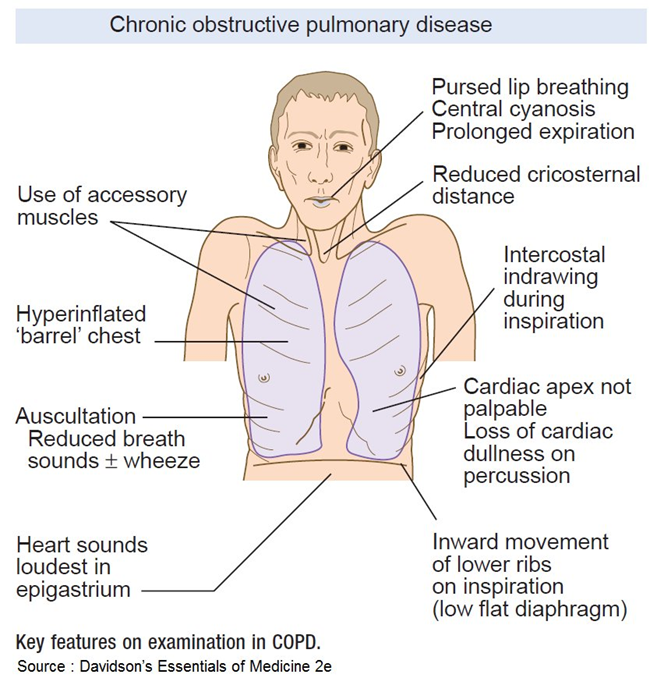An admitting nurse is assessing a client with COPD. The nurse auscultates diminished breath sounds. These findings indicated the nurse to monitor the client for what?
Kyphosis and clubbing of the fingers
Dyspnea and hypoxemia
Sepsis and pneumothorax
Bradypnea and pursed-lip breathing
The Correct Answer is C
A. Kyphosis and clubbing of the fingers:
Kyphosis refers to an excessive forward curvature of the spine, which is not directly related to diminished breath sounds. Clubbing of the fingers is often associated with chronic respiratory conditions, but it is not directly linked to the finding of diminished breath sounds.
B. Dyspnea and hypoxemia:
Dyspnea (shortness of breath) and hypoxemia (low oxygen levels in the blood) are common symptoms in COPD, but diminished breath sounds may indicate an additional concern, such as pneumothorax or other complications.
C. Sepsis and pneumothorax:
Diminished breath sounds can be a sign of pneumothorax, a condition where air accumulates in the pleural space, leading to lung collapse. Sepsis is a risk in clients with COPD due to the potential for respiratory infections. Monitoring for these complications is crucial.

D. Bradypnea and pursed-lip breathing:
Bradypnea (slow breathing) and pursed-lip breathing are coping mechanisms that individuals with COPD may use to manage their breathing difficulties. While they are relevant in the context of COPD, they are not directly associated with the finding of diminished breath sounds.
Nursing Test Bank
Naxlex Comprehensive Predictor Exams
Related Questions
Correct Answer is D
Explanation
A. Monitor daily weights and urine output.
Monitoring daily weights and urine output is an important aspect of managing heart failure or other cardiac conditions. However, in the context of a client with chest pain, ST elevation, and elevated cardiac enzymes (indicating a myocardial infarction), the immediate focus is on addressing the acute event and reducing myocardial oxygen demand.
B. Administer TPA to prevent further damage as a result of a clot.
Tissue plasminogen activator (TPA) is a thrombolytic medication that can be administered to dissolve blood clots in the coronary arteries during a myocardial infarction. However, the administration of TPA has a specific timeframe within which it is most effective. It is crucial to know the elapsed time since the onset of symptoms, and there are specific criteria and contraindications for its use.
C. Provide client education on medications and diet to prevent recurrence.
Client education on medications, lifestyle modifications, and dietary changes is an essential component of long-term management for preventing recurrence of cardiovascular events. However, during the acute phase of a myocardial infarction, the immediate priority is to stabilize the client and address the acute event, with education being a secondary consideration.
D. Reduce pain and myocardial oxygen demand.
During the acute phase of a myocardial infarction, reducing pain and myocardial oxygen demand is the highest priority. This is typically achieved through the administration of medications such as nitroglycerin for vasodilation and opioids for pain relief. Other interventions to optimize oxygen supply and demand, such as supplemental oxygen and reperfusion strategies, may also be considered.
Correct Answer is D
Explanation
A. Coronary artery disease (CAD):
Coronary artery disease primarily affects the blood vessels supplying the heart muscle. Symptoms often include chest pain (angina) rather than pain in the lower extremities. The symptoms described in the scenario are not characteristic of CAD.
B. Arterial embolus:
An arterial embolus is a blood clot or debris that travels through the bloodstream and can block an artery. While it can cause decreased blood flow and pain, the presentation in the lower left leg and foot with relief of pain at rest is more suggestive of peripheral arterial disease (PAD) or intermittent claudication rather than an acute arterial embolus.
C. Raynaud disease:
Raynaud's disease is characterized by episodes of reduced blood flow to the extremities, usually triggered by cold or stress. It typically involves color changes (white, blue, red) in the fingers or toes. The symptoms described, including pain in the lower leg and foot during walking, are not typical of Raynaud's disease.
D. Intermittent claudication:
Intermittent claudication is a symptom associated with peripheral arterial disease (PAD). It involves pain or cramping in the legs during physical activity, such as walking, due to reduced blood flow to the muscles. Rest typically relieves the pain. The observation of a hairless leg and slight edema suggests potential vascular compromise in the lower extremity, supporting the diagnosis of intermittent claudication.
Whether you are a student looking to ace your exams or a practicing nurse seeking to enhance your expertise , our nursing education contents will empower you with the confidence and competence to make a difference in the lives of patients and become a respected leader in the healthcare field.
Visit Naxlex, invest in your future and unlock endless possibilities with our unparalleled nursing education contents today
Report Wrong Answer on the Current Question
Do you disagree with the answer? If yes, what is your expected answer? Explain.
Kindly be descriptive with the issue you are facing.
